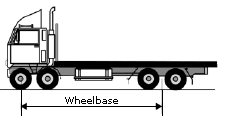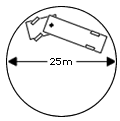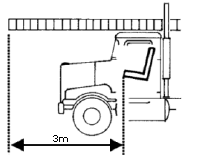An introduction programme for drivers of heavy motor vehicles.


The distance between the centres of each tyre on an axle is known as the track. The wider the track, the better the stability of the vehicle will be. In other words the wider the vehicle, the more stable (within the maximum permitted vehicle dimensions) it will be. This results in better handling and improves the overall dynamics of the vehicle.

The wheelbase of a rigid motor vehicle is the distance between the centre of the rear axle(s) and the centre of the front axle. In a twin-steer vehicle, the wheelbase is measured between the centre of front (foremost) steering axle and the centre of the rear axle(s).

The length of a vehicle's wheelbase is major factor in the manoeuvrability of the vehicle. The longer the wheelbase the less manoeuvrable the vehicle is likely to be. All motor vehicles in New Zealand must be able to complete a 360-degree turn, both to the left and to the right, within a circle with a wallto- wall diameter of 25 metres. The only projections which can be outside this circle are collapsible mirrors. It is for this reason, to improve manoeuvrability, that vehicles used in areas where manoeuvrability is important, such as rubbish collection, often have their front, steering axles moved backwards. This is called an offset front axle.
However, moving the front axle backwards can place an additional load on the front axle and upset the balance of the load between the front and rear axles, thus affecting brake balance and load transfer.

Overhang in either the front or rear will also affect the manoeuvrability of the vehicle. In New Zealand, front overhang is measured from the front edge of the driver's seat (in its rearmost position) to the foremost point of the vehicle or its load. The maximum permitted front overhang is three metres.
When front overhang is excessive, the part of the load that is overhanging the vehicle will travel in a wider arc than that taken by the rest of the vehicle and may come into contact with a vehicle in the other driving lane or even a building on the other side of the road.

Rear overhang means the distance from the rear axis to the rear of the vehicle or its load, whichever is greater. For a heavy rigid vehicle, in which the rearmost axle is a non-steering axle, the maximum rear overhang is either 4 metres or 70 percent of wheelbase (A in the diagram), whichever is lesser.
The affect on the manoeuvrability of a vehicle with excessive rear overhang is similar to that with excessive front overhang, that is, the extra length of the load will swing wide and may come into contact with a object on the other side of the road or a vehicle travelling in the another lane.
No two corners are exactly the same, so road controlling authorities sometimes provide an indication of a corner's severity by using advisory signs.

These signs often include a recommended speed and a diagram of the corner's line. The recommended speed is set for cars and not trucks, so in most circumstances the posted speed will be too high for a truck to safely negotiate the curve. To safely go around the bend in a truck the speed of the truck should be at least 10 km/h lower than what the sign indicates.
For example, the signs above indicate that the curve ahead has an advisory speed limit of 65 km/h. For a truck to safely go around this curve it should be going no faster than 55 km/h.
Drivers of vehicles who have been in rollover or had severe loss of control situations will often not have had any sense that the vehicle is about to go out of control until it happens. By this time it is often too late to take any corrective action. Some drivers however may recall sensing a load shift immediately before loosing control of the vehicle and will often blame this as the cause of the crash. However, investigations have found that often the shifting load was a result of excessive vehicle tilting, resulting from the driver losing control of the vehicle, and not the cause of it.
By far the most important aspect of dynamics control is the driver's response to corners. While every corner is different, each has three definite points.
1 Entry

This is where the driver begins to turn the steering wheel to enter the corner. At this point the driver must have completed all deceleration, braking and downshifting. They should be at, and maintaining, the desired speed as they enter the bend.
2 Apex
This is the point where the vehicle is closest to the inside of the turn. The driver should maintain the entry speed to this point and now start to slowly accelerate. The steering line should now be completed.
3 Exit
The driver should have accelerated from the apex to this point, which is where the vehicle returns to a straight line.
Vehicle rollovers normally occur between the apex and the exit of a corner as a result of excessive speed or braking. When towing a trailer, the prime mover must pull the trailer through the bend, not be pushed by it. This can only be achieved with the cornering technique. Cornering stability will be improved and the effects of centrifugal force reduced if the correct cornering line is also applied.